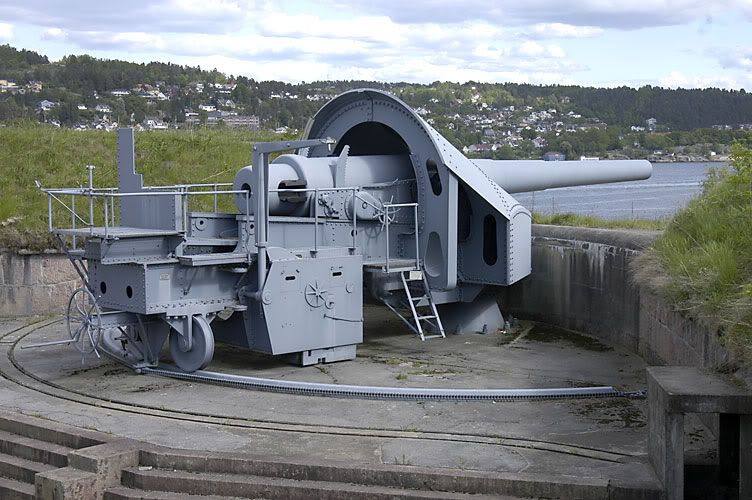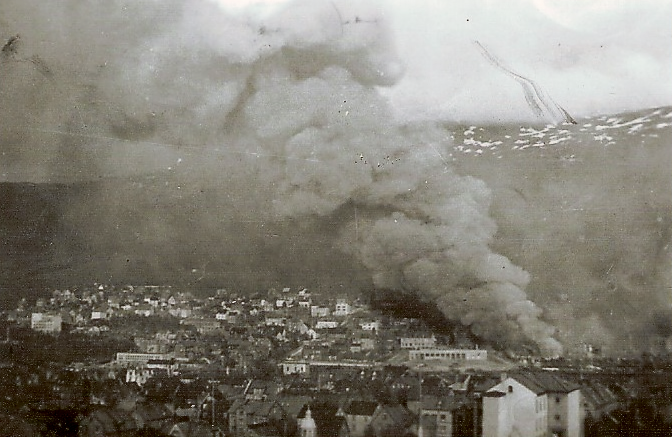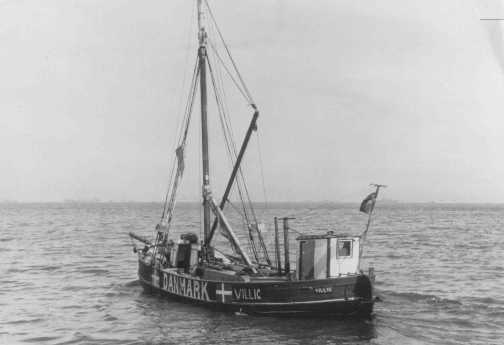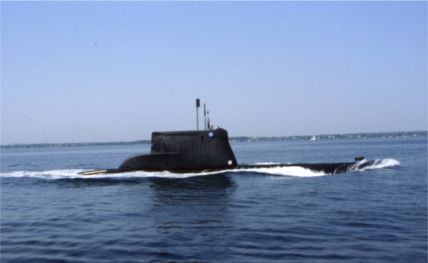It was seventy years ago today that World War II came to Norway and Denmark.
As with the previous episode in this series, the Invasion of Poland, history has spawned all kinds of myths about this campaign.
Norway and Denmark, like many other smaller European nations, had actively embraced the idea of neutrality as their best defense against huge potential enemies like Germany, the USSR and, believe it or not, France and the UK. Indeed, that was what “neutrality” meant, in the full legal sense of the term, for countries that embraced it; they could not distinguish between liberal democracies like Britain and fascist dictatorships like Germany; they had to treat all nations as the same, and all belligerents in a war as equally culpable.
This, believed the Danes and Norwegians, was their best shot at avoiding war; taking absolutely no side in the conflict.
And it’s one of histories great accidents that in Norway’s case it didn’t turn out to be true, at least legally. Winston Churchill noted that much of the steel that ran Germany’s war machine came from iron ore mined in northern Sweden, and exported via train to Narvik, Norway, and thence shipped to Germany. Churchill hatched a plan; to send a brigade of British soldiers to occupy Narvik first, and work out the diplomatic details with the Norwegians later. And so in the days leading up to April 9, 1940, the British embarked a brigade of infantry onto a couple of cruisers and got ready to send them to Norway.
The Germans got there first.
They had engineered a pretty elaborate surprise attack; they put most of their troops on warships, fast cruisers and destroyers, rather than on regular transports and landing ships. They also staged the world’s first major airborne assault, sending the paratroopers (Fallschirmjäger) to capture Norway’s major airport and, they hoped, King Haakon and his cabinet.

The German surprise attack wasn’t a complete surprise; British intelligence got some word out in advance. A Polish submarine, the Orzel, which had itself escaped the conquest of Poland only eight months before, sank a transport off Lillesand, and a British sub damanged a cruiser full of troops. And one group of German ships encountered the Norwegian patrol boat Pol the night before the invasion, as the ships were staging to launch their assaults in the morning. They sank the Pol, whos captain became the first fatality of many the next day.
But it was a home-field game for the Germans; Denmark was on their own border, and Norway was much closer to Germany than to the UK or France.
Despite the three naval actions the day before, the word was slow in getting to the governments in London and Oslo; the Norwegian government, realizing they had no hope of preserving peace, ordered an alert – which, being far too late, did little good – and started packing up the nation’s gold reserves (which did succeed).
And so on the morning of April 9, a coordinated six-point assault with elements of six infantry and mountain divisions simultaneously invaded the six most important cities in Norway. Two German battlescruisers carried elements of a Mountain Division to Narvik, well above the Arctic circle, destroying two of Norway’s ancient “battleships”, the Eidsvold and the Norge, leaving a few dozen survivors out of crews totalling 300 men. Other ships landed troops at Trondhjem, Bergen, Kristiansand and Egersund; the biggest detachment sailed up Oslofjord to try to capture Oslo, link up with the paratroopers, and try to decapitate whatever command and control Norway had.
And so the Germans essentially drove into Denmark, and debouched from ships and planes into Norway. The Danes, having a tiny military, indefensible terrain, and no real chance at defense, worked out an armistice quickly that enabled them to keep at least some small degree of autonomy under German rule – which would hold for the next couple of years.

For the most part, the strikes on Norway went off with surgical assurance and with little overt resistance; Norway had nearly disbanded her military, and had only very recently realized that pacifism needed some form of defense; they’d begun building a few new destroyers (to replace vessels commissioned in the 1890s), and bought fighter and anti-submarine planes from Britain and the US – although by April 9, only 12 British-built Gloster Gladiator biplanes were combat-ready.

All 12 were destroyed by the end of the first day – although not before shooting down several German planes full of paratroopers first.
But for the key part of the German plan – the capture of King Haakon, his cabinet, the Storting (Parliament), the gold reserves and the legitimate government of Norway ? The wheels came off, unpredictably, bright and early.
The biggest of the German invasion forces stormed into Oslofjord on the morning of April 9. Lead by the heavy cruiser Blücher, the force included two other heavy cruisers, three destroyers, and eight other ships crammed with German infantry. Norway had very few formal defenses – but the Oscarsborg fortress, sitting in at a narrowpoint in the fjord, was one of them. The commander of the fortress, Colonel Birger Eriksen, sensing trouble, had put his troops on alert on his own initiative, disobeying an order to stand down.

And at 5:15AM, his searchlights illuminated Blücher; his fortress’ main battery, two 11-inch cannon that’d been installed in 1892, engaged the cruiser.

Two hits blew a turret off of the cruiser, and forced it to stop – leaving it a sitting duck for an 1890-vintage torpedo, fired from a glorified log flume on shore, which caused Blücher to tip over on its right side and sink, ablaze, killing 1,000 sailors and soldiers, including many specialists and administrators who were to take over the running of the Norwegian government.
This blocked the fjord, preventing the force from getting to Oslo long enough for the King, Cabinet, Parliament, and the gold supply to evacuate.
The Germans needed Haakon and his Cabinet; if they could be captured and induced to capitulate, it would mean that Germany controlled Norway’s legitimate government. And so they sent an elite force of paratroopers in a convoy of commandeered civilian trucks to try to intercept Haakon’s convoy as it fled into the interior.
They nearly succeeded. But at the village of Midtskogen Gard, they ran into a group of Royal Guards and “reservists” – hunting club members, really – who blocked them and, in a short, sharp battle, turned them back.
And so Haakon and his government managed to escape into the interior, where they led Norway’s tiny, hardscrabble Army in resistance for nearly two months, before evacuating from Tromsö aboard a British cruiser on June 7.

Norway thus became the only country conquered by Hitler to never surrender to the Nazis. Haakon, leading Norway’s legitimate government (no country ever recognized, even by the dubious standards of world diplomacy, Vidkun Quisling’s puppet regime) at the head of over 20,000 troops in exile, 50,000 troops in the underground, and the 22,000 men and hundreds of ships of Norway’s merchant marine.
It was five years to the day later that Haakaon returned to Norway at the head of his military (escorted by the US 99th Infantry Battalion, made up of Norwegian-speaking GIs from Minnesota, the Dakotas and Michigan) in 1945.
———-
As I’ve done throughout this series, I’m here to debunk myths.
There are several in re the war in Scandinavia.
No Pushover: While the popular history has it that Norway rolled over quickly for the German attack, the fact is that not only did Norway never surrender (as noted above), but the campaign became a bit of a quagmire, at least initially, for Germany. The initial invasion used six divisions and parts of a seventh, and still couldn’t conquer the whole country.

To make matters worse for the Germans, the British expeditionary force originally slated to invade Norway ended up arriving in Narvik after the Germans – to be seen as liberators and rescuers. The British navy task force delivering them, led by the battleships HMS Warspite, wiped out the German naval force at Narvik, including ten destroyers – a blow from which the German destroyer force never recovered throughout the war.

The Allied ground force – including British, French, Norwegian and Polish-Army-In-Exile forces – drove the Germans out of the city, and held until evacuated in June. The Norwegians operating outside Narvik, under General Fleischer, delivered the first tactical defeat suffered by the German Army in World War II.

Farther down-country, the Norwegians – again, mostly gun-club “reservists”, with French and British troops in support- delayed, and then halted, the German advance up-country during the campaign around Namsos, which was finally overcome only through the lack of Allied air support and, finally, the fall of France.
As the quagmire dragged on, the Germans got desperate, carrying out terror-bombing attacks on Nybergsund, Andalsnes, Molde, Elverum, Kristiansund, Namsos and Narvik.

The last Norwegian army unit fighting in Norway didn’t cease organized resistance until June 10; Norway resisted longer than than of any of Hitler’s other conquests.

Resistance: Tens of thousands of Norwegians escaped Norway; fifty thousand more fought in some capicity or another in the Resistance. The Milorg achieved some spectacular successes, including the destruction of the German “Heavy Water” supply during the Vemork raid. Germany stationed a total of eighteen divisions in Norway on occupation duty during the war – partly testament to the importance of Germany’s bases, which supported U-boat and air raids on convoys crossing the Atlantic and especially those supplying Lend-Lease supplies to the USSR – and also to the effectiveness of Norway’s resistance. It was the highest ratio of occupation troops to civilians anywhere in Europe.
Denmark resisted as well; indeed, given the more difficult terrain, the Danish resistance was especially crafty, adaptible and ferocious. And both nations pulled off the incredible; during a three-week stretch in 1943, the Danish resistance managed to smuggle 86% of Denmark’s Jews to safety in Sweden, after word got out that Hitler was about to abrogate the terms of Denmark’s armistice and round the Jews up for extermination.

Norway similarly got 75% of its Jewish population smuggled to Sweden, albeit in less dramatic fashion. Both nations’ resistance groups are listed collectively among the “Righteous Among Nations” at Yad Vashem.
Exile: Among the Norwegians and Danes who escaped to fight onward, many distinguished themselves. The Canadian government, using airplanes Norway had bought from the US but were not delivered, set up a training base for Norwegian pilots, “Little Norway”, near Toronto. The Norwegian pilots served with distinction; 331 and 332 Squadrons, flying Spitfires, became among the highest-scoring squadrons in the Royal Air Force late in the war, flying air cover over the Normandy invasion, the liberation of Holland, and the crossing of the Rhein River.

At sea, Norway’s huge merchant fleet was a huge part of the Allied effort to first keep Britain from starving, and then to support the invasion and liberation of Europe. Beyond that? Norwegian crews on British-built torpedo boats and gunboats, and two British-built submarines – the Uredd, lost in a minefield, and the Ula, which sank more enemy tonnage than any other Allied submarine in the Atlantic during World War II – vexed the occupiers up and down Norway’s long coastline.

Lessons Learned: Norway has always had a reputation for big-L “liberalism”, which it passed on to its descendants in Minnesota.
But it learned its lesson, too. During the Cold War, when faced with an enemy historically even worse than Hitler (remember – Norway and Turkey were the only NATO nations to share borders with the USSR), they backed up their innate pacifism with a big stick.

Although the nation has about the same population as Minnesota, it built up a sizeable navy to defend its long, craggy coastline from invasion – and turned virtually its entire male population into an army. Norwegians served in a system similar in many ways to that of Switzerland and Israel, keeping their weapons at home, ready for the worst. The nation’s military was trained for guerilla warfare; a hypersecret branch of Norway’s special forces spent the Cold War years building the infrastructure to make another occupation of Norway a horrible and bloody thing for the next round of enemies.

For it’s part, the Danish military after World War II developed a reputation for fierceness; Danish troops serving in Bosnia/Herzegovina were reportedly among the most aggressive in smacking down Serb aggression. It’s worth noting that Danish special forces – the Jaegerkorpset, among the most admired special opertions forces in NATO – accompanied the US in its initial invasion of Iraq, along with those of Poland, another nation that had learned the hard way that freedom needed fierce defense.

As we confront our nation’s own tribulations, we’d do well to remember the examples of the people of Norway and Denmark.
Leave a Reply
You must be logged in to post a comment.